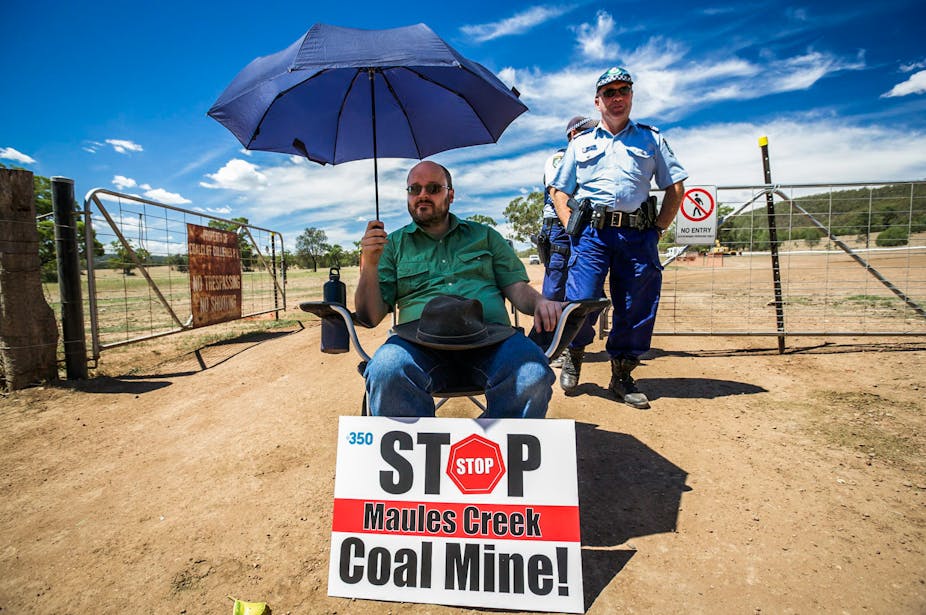The infiltration of anti-coal protests in New South Wales by spies employed by a private security company is unlikely to be a one-off event. More likely, the revelations of spying on the Maules Creek and Boggabri activists is a rare ray of light into a dark world of surveillance of conservation groups.
Official anxiety about climate change activism has been on the rise for a decade, expressed partly in the strengthening of state and federal laws against demonstrations at coal-fired power plants.
Former Labor federal energy minister Martin Ferguson used to speak bluntly about the need to take stronger measures against anti-coal activism. In 2009 he asked the attorney-general to use the federal police to gather intelligence on activists. In 2012, the then attorney-general Nicola Roxon effectively admitted that ASIO and the federal police were spying on environmentalists, although her office insisted that this activity was limited to potentially violent protests.
We can expect the present government to show little restraint in the use of covert activities against climate protesters, including infiltration and disruption.
In his post-budget speech to captains of the mining industry, Prime Minister Tony Abbott declared that exporting coal to the world is Australia’s “destiny”, and that nothing would damage our future more than leaving coal in the ground.
While the prime minister was bewailing attempts to “demonise the coal industry”, the mining industry has made it clear that the gloves are off. Both industry and government want to curtail the right to protest, effectively to limit it to petitions and letters to the editor. The criminalisation of protest and intimidation of protesters represents an attack on the democratic space.
What else is going on?
In addition to the ham-fisted private spying on Boggabri and Maules Creek activists, undercover operations and intelligence monitoring is almost certainly being undertaken by Australia’s official intelligence services, although it ought to be more difficult for the protesters to expose spies sent by ASIO or the federal police.
ASIO, Australia’s premier domestic spy agency, has had its resources expanded enormously over the past decade. Its surveillance and interrogation powers have also been extended, to the point where in the view of some legal experts, such as University of New South Wales professor George Williams, they approach those of a police state.
Savvy campaigners now assume that their communications are being routinely monitored. Greenpeace activists, for example, are in the habit of turning off their mobile phones when discussing campaigns. They leave them in another room under a pile of magazines, aware that they can be turned on remotely and used as listening devices. The video and audio facilities of their computers can also be used for snooping by outside forces. Putting masking tape over webcams is now a standard precaution.
US-style spying
Corporate espionage against non-profit organisations – including computer hacking, infiltration and “dumpster-diving” – is entrenched in the United States. There, as here, private spies talk to government spies. Security companies are typically staffed by former members of military intelligence or federal security agencies, and their contacts are their most valuable asset. Three of those allegedly linked to the Maules Creek and Boggabri covert operations have previously worked for military or police agencies.
We don’t know how deeply linked Australia’s network of private security consultants is to spy agencies and corporations, or the extent to which these different groups are sharing information about environmental activists.
It is difficult to know whether Australian spy agencies are engaged in the kind of sustained infiltration of environmental organisation that has been uncovered in Britain. There, police operatives have been posing as environmental activists for years – their cover was so deep that eight women took legal action because they had sexual and emotional relationships with men who were later exposed as spies.
They say they were used “physically and emotionally” by these men to gather intelligence. One undercover policeman, Mark Kennedy, is alleged to have had intimate relationships with three activists. The women say they feel violated.
In the United States, government agencies, private contractors and big corporations have been exchanging information on activists with a view to upsetting their plans and tarnishing the reputations of those involved.
And it has been revealed that the Communications Security Establishment Canada – which, like ASIO, is a member of the “Five Eyes” program of English-speaking intelligence services – works closely with Canadian corporations. It is entirely possible that the Maules Creek-Boggabri episode is just the tip of the iceberg in Australia.
Corporate and government spying on groups who campaign on issues ranging from climate change and animal rights to toxic chemicals and consumer protection is an invasion of their privacy and an attack on civil society. A democracy without the opportunity for vigorous, non-violent protest is no democracy at all.

